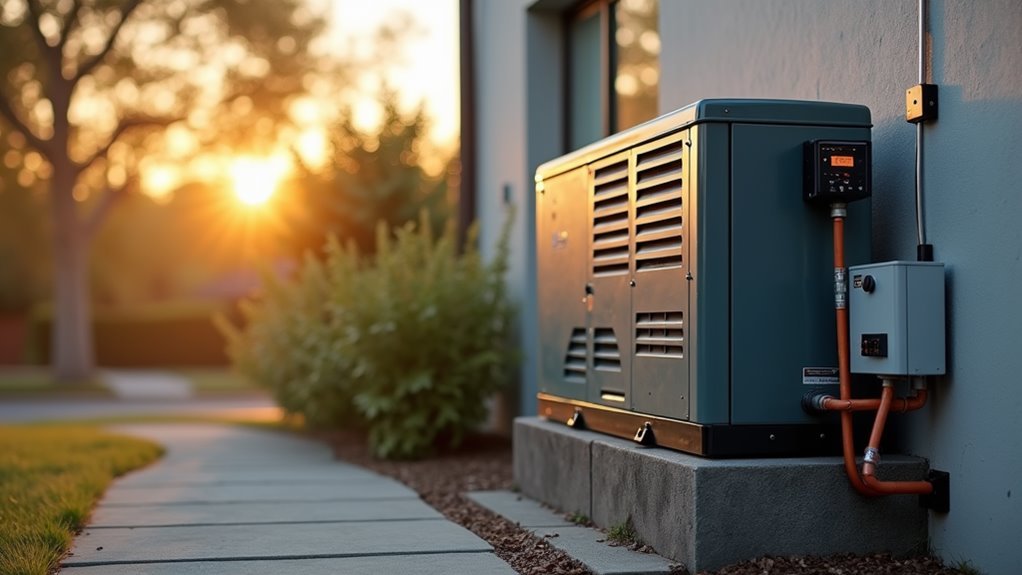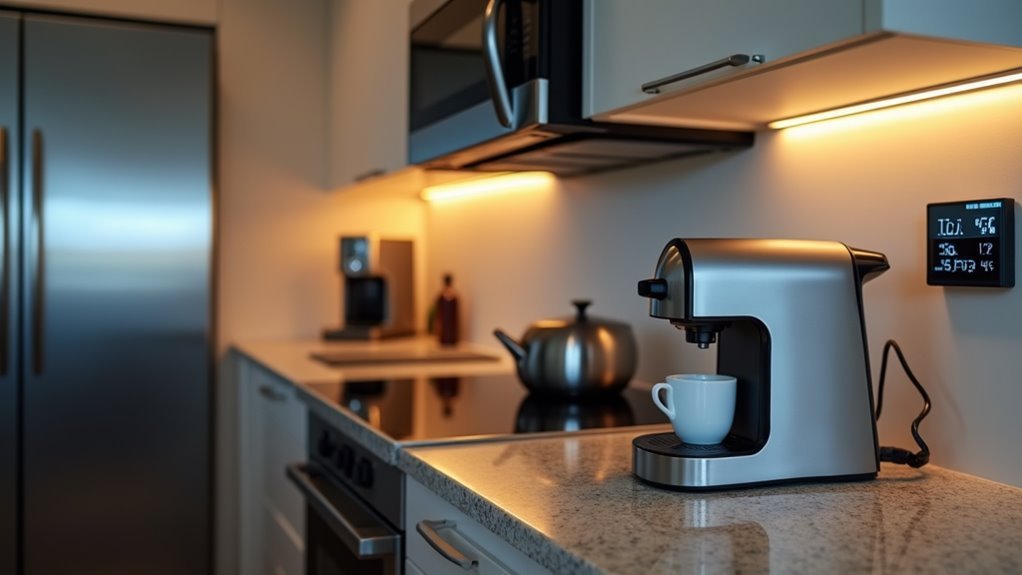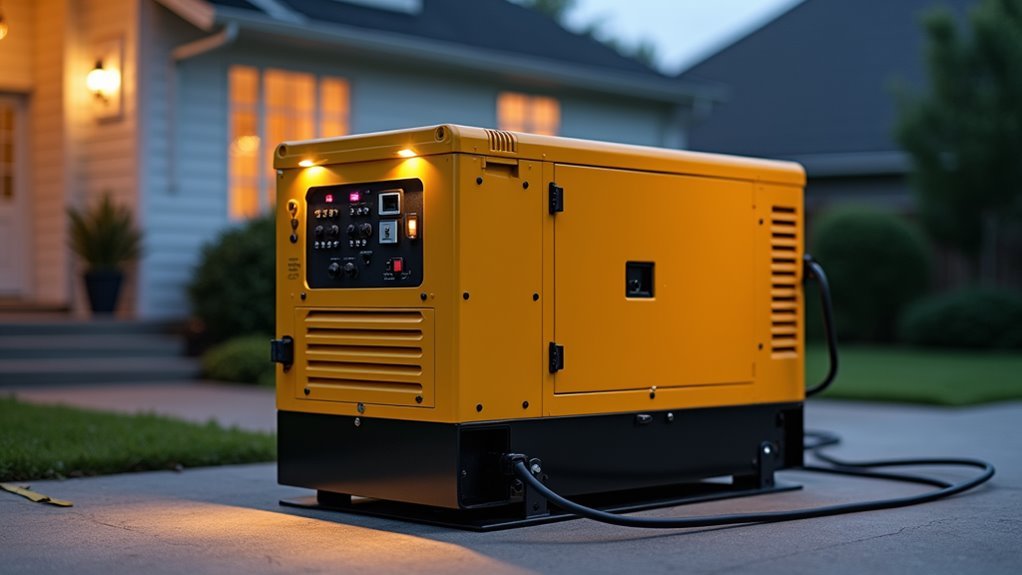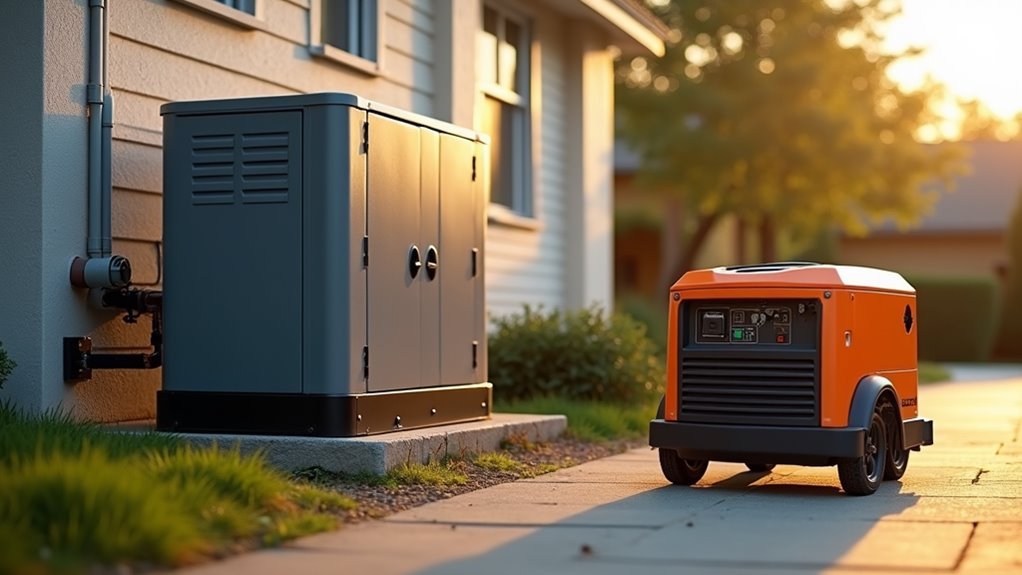We're all familiar with the sinking feeling when the power goes out, leaving us wondering if we've got the right generator to keep our essential appliances running. It's not just about picking any generator – we need to understand the complex interplay between running watts, surge requirements, and our home's specific power demands. Whether you're preparing for emergencies or planning off-grid adventures, knowing how to properly size a generator can mean the difference between staying comfortable and sitting in the dark. Let's uncover the critical factors that'll guarantee you make the right choice.
What Are Running Watts

Running watts, also known as continuous watts, represent the amount of power needed to keep electrical devices operating normally once they're already started. This is the steady power consumption you'll see on your appliances and tools during regular operation.
Let's think about running watts like keeping your car at a steady speed on the highway. Once you're cruising along, you don't need as much power as you did to get moving. We see this with our refrigerators, air conditioners, and other appliances – they need a certain amount of consistent power to keep running smoothly.
When we're choosing a generator, we need to add up the running watts of all the devices we want to power at the same time.
For example, if we're planning to run a refrigerator (800 watts), some lights (400 watts), and a television (200 watts), we'll need at least 1,400 running watts. This helps us ascertain our generator can handle our everyday power needs without struggling or shutting down.
It's crucial to get these calculations right to maintain our independence during power outages. Proper installation and maintenance are essential to ensure that the generator operates effectively and safely when it's needed most.
Understanding Surge Power Needs
Many electrical devices require a powerful jolt of extra electricity when they first start up – this is called surge power or starting watts. We'll need to account for these surge requirements when choosing a generator, or we might find ourselves unable to power our essential equipment when we need it most.
Let's look at some common appliances and their surge power needs compared to their running watts. These numbers will help us make smart choices about our power independence:
| Appliance | Running Watts | Surge Watts |
|---|---|---|
| Air Conditioner | 1500 | 2200 |
| Refrigerator | 700 | 2200 |
| Well Pump | 1000 | 2100 |
| Power Tools | 1200 | 3600 |
| Sump Pump | 800 | 2400 |
When we're calculating our generator needs, we'll want to add up the surge watts of the largest motor-driven appliance we'll start first, plus the running watts of everything else we'll power at the same time. This gives us our minimum generator size. Regularly ensuring proper oil maintenance for your generator can help it handle those surge requirements more effectively. Remember, it's better to have a little extra capacity than not enough when we're trying to keep our home or workspace powered up.
Common Household Appliance Requirements

A home's electrical devices vary widely in their power consumption, from small appliances drawing just a few watts to major systems requiring thousands.
Let's break down some common power needs so we'll know exactly what our generator must handle.
We'll find that our kitchen appliances are among the heaviest power users. A refrigerator typically needs 600-800 watts to run, while a microwave demands around 1,000 watts. If we're thinking about air conditioning, we're looking at 1,500-3,500 watts depending on the unit's size.
Our basic electronics like TVs and computers are much gentler, usually drawing 200-400 watts.
It's important to note that some devices, like our washing machine and dishwasher, need extra power to start up. A washing machine might run on 500 watts but require 2,250 watts to start.
When we're adding up our needs, we should list both running and startup watts for each appliance. We'll want to keep a chart of our most-used items handy, making it easier to calculate our total power requirements when selecting a generator.
Calculating Total Power Demand
To properly size a generator, we need to add up both the running and peak power demands of all devices we plan to use simultaneously.
Let's start by making a list of essential appliances and their wattage requirements, then add up their running watts for our baseline power needs.
We'll also need to take into account startup surges, which can be two to three times higher than running watts.
For example, if we're running a refrigerator (800 watts) and want to start our air conditioner (2,200 watts plus 3,300 surge), we'll need at least 4,100 watts of power at that moment. It's smart to give ourselves some extra cushion, too.
Don't forget about seasonal changes in our power needs. During summer, we might need more capacity for air conditioning, while winter could demand more power for heating devices.
By calculating our highest possible power demand scenario and adding 10-20% for safety, we'll make sure our generator can handle whatever we throw at it.
Let's always round up rather than down – it's better to have a bit too much power than not enough when we need it most.
Choosing Generator Size

Now that we've calculated our total power needs, selecting the right generator size becomes straightforward.
We'll want to choose a generator that can handle our maximum power requirements while giving us some extra capacity for peace of mind. It's always better to have a little more power than not enough when you're trying to maintain your independence and keep your essential systems running.
Here's what we need to take into account when selecting our generator size:
- Add 20% to our calculated total wattage to create a safety buffer that accounts for power surges and future needs.
- Look for a generator rated at "continuous" or "running" watts that meets or exceeds our buffered total.
- Consider the "starting" or "surge" watts rating, which should be about 1.5 times the running watts to handle motor startups.
Power Management Strategies
Successfully managing your generator's power output requires smart planning and strategic load distribution. We'll help you maximize your generator's capacity while avoiding overloads that could damage your equipment or leave you in the dark.
Let's start by breaking down your power needs into essential and non-essential loads. We always recommend running your most critical items first – like refrigerators, heating systems, and medical equipment. Once those are running smoothly, you can rotate other appliances based on your generator's capacity. Don't forget to stagger the startup of heavy-draw appliances to prevent power surges.
A simple but effective strategy is creating a power schedule. We can split our day into blocks, running energy-hungry appliances like washers and microwaves at different times. This prevents overtaxing the generator and guarantees steady power for everything we need.
Consider using power strips to quickly switch between device groups, and keep a running tally of your wattage usage. With these strategies, we'll help you get the most from your generator while maintaining the freedom to power what matters most.
Safety Margins and Derating

While managing power loads helps prevent generator strain, understanding safety margins and derating factors provides an extra layer of protection.
We've learned that it's smart to choose a generator with at least 20% more capacity than our calculated power needs. This safety margin affirms we're not pushing our equipment to its limits and helps it last longer.
When we're picking out a generator, we need to take into account these key derating factors that affect its performance:
- Altitude reduces generator output by about 3.5% for every 1,000 feet above sea level
- High temperatures can decrease performance by up to 2% for every 10°F above 77°F
- Age and wear naturally lower a generator's maximum output over time
We shouldn't rely on the manufacturer's peak wattage rating alone.
Instead, we'll get better performance by calculating our needs, then adding our safety margin, and finally adjusting for these derating factors. This approach gives us peace of mind knowing we've got enough power when we need it most, whether we're running our home during an outage or powering up our off-grid cabin.
Essential Vs Optional Equipment
Prioritizing equipment during power outages helps us make smart decisions about generator capacity. When we're planning our backup power needs, we'll want to separate our must-have items from those we can live without. Let's focus first on what keeps us safe and comfortable during emergencies.
To help us decide what's essential and what's optional, we've created this practical guide that breaks down common household equipment:
| Equipment Type | Essential or Optional |
|---|---|
| Refrigerator | Essential – Food Safety |
| Medical Devices | Essential – Health |
| Heating/Cooling | Essential – Survival |
| Entertainment | Optional – Comfort |
| Decorative Lights | Optional – Aesthetics |
We'll want to calculate our total wattage starting with essential items first. Remember, we can't run everything at once, but we can rotate our power usage between different appliances. By identifying what's truly necessary, we're able to choose a generator that meets our critical needs without overspending on capacity we don't really need. This strategy gives us the freedom to maintain our essential lifestyle during outages while being practical about our power usage.
Portable Vs Standby Options

Choosing between portable and standby generators comes down to our specific power needs, budget, and installation requirements.
While portable units offer flexibility and lower upfront costs, standby generators provide automatic, whole-house coverage during outages.
We'll help you understand the key differences to make the best choice for your situation.
Portable generators give us the freedom to:
- Power essential equipment during short outages or outdoor activities
- Move the unit where it's needed most, from camping trips to emergency situations
- Save money with a smaller initial investment and simpler maintenance
Standby generators, while more expensive, offer permanent peace of mind through automatic operation.
They're professionally installed next to our homes and connect directly to our electrical systems.
When the power goes out, they spring into action within seconds – no manual starting required.
We won't need to worry about fuel storage or extension cords, since they're typically powered by natural gas or propane and integrated into our home's wiring.
Understanding these differences helps us determine which type aligns with our lifestyle, budget, and backup power goals.
Frequently Asked Questions
How Long Can I Safely Run My Generator Continuously?
We recommend running most portable generators for 8-24 hours at a time, but you'll want to check your specific model's manual since run times vary between manufacturers and fuel types.
Can Extreme Weather Conditions Affect My Generator's Power Output?
We'll face reduced generator output in extreme weather. High temperatures can decrease performance by 1-2%, while freezing conditions affect fuel systems and batteries. It's essential to protect against these elements.
What Type of Fuel Provides the Most Efficient Generator Operation?
We're empowered to share that diesel fuel delivers our most robust energy returns. It's more efficient than gasoline or propane, offering longer runtime and superior fuel economy for your independence.
How Often Should Generators Undergo Professional Maintenance and Inspection?
We recommend having our generators professionally serviced every 100 operating hours or annually, whichever comes first. Don't skip maintenance – it's essential for keeping our backup power ready when needed.
Will My Generator's Performance Decrease With Age and Regular Use?
Like cars and computers, generators naturally lose efficiency over time. We'll notice reduced power output and increased fuel consumption, but regular maintenance helps slow this decline and extends peak performance.
Conclusion
We've journeyed through the wattage wilderness together, and now we're all a bit smarter about not letting our generators throw tantrums when the microwave and AC decide to party at the same time. Remember, there's no shame in doing the math – it's way better than sitting in the dark wondering why your 2000-watt generator can't handle your 3000-watt needs! Let's power up wisely and keep those electrons flowing smoothly.